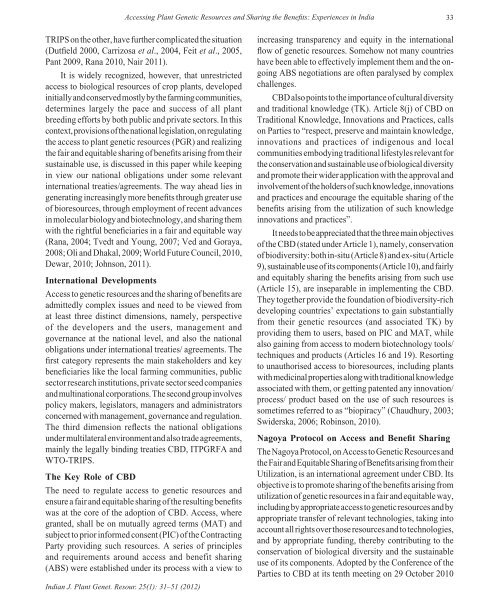indian society of plant genetic resources - Bioversity International
indian society of plant genetic resources - Bioversity International
indian society of plant genetic resources - Bioversity International
Create successful ePaper yourself
Turn your PDF publications into a flip-book with our unique Google optimized e-Paper software.
Indian J. Plant Genet. Resour. 25(1): 31–51 (2012)<br />
Accessing Plant Genetic Resources and Sharing the Benefi ts: Experiences in India 33<br />
TRIPS on the other, have further complicated the situation<br />
(Dutfi eld 2000, Carrizosa et al., 2004, Feit et al., 2005,<br />
Pant 2009, Rana 2010, Nair 2011).<br />
It is widely recognized, however, that unrestricted<br />
access to biological <strong>resources</strong> <strong>of</strong> crop <strong>plant</strong>s, developed<br />
initially and conserved mostly by the farming communities,<br />
determines largely the pace and success <strong>of</strong> all <strong>plant</strong><br />
breeding efforts by both public and private sectors. In this<br />
context, provisions <strong>of</strong> the national legislation, on regulating<br />
the access to <strong>plant</strong> <strong>genetic</strong> <strong>resources</strong> (PGR) and realizing<br />
the fair and equitable sharing <strong>of</strong> benefi ts arising from their<br />
sustainable use, is discussed in this paper while keeping<br />
in view our national obligations under some relevant<br />
international treaties/agreements. The way ahead lies in<br />
generating increasingly more benefi ts through greater use<br />
<strong>of</strong> bio<strong>resources</strong>, through employment <strong>of</strong> recent advances<br />
in molecular biology and biotechnology, and sharing them<br />
with the rightful benefi ciaries in a fair and equitable way<br />
(Rana, 2004; Tvedt and Young, 2007; Ved and Goraya,<br />
2008; Oli and Dhakal, 2009; World Future Council, 2010,<br />
Dewar, 2010; Johnson, 2011).<br />
<strong>International</strong> Developments<br />
Access to <strong>genetic</strong> <strong>resources</strong> and the sharing <strong>of</strong> benefi ts are<br />
admittedly complex issues and need to be viewed from<br />
at least three distinct dimensions, namely, perspective<br />
<strong>of</strong> the developers and the users, management and<br />
governance at the national level, and also the national<br />
obligations under international treaties/ agreements. The<br />
fi rst category represents the main stakeholders and key<br />
benefi ciaries like the local farming communities, public<br />
sector research institutions, private sector seed companies<br />
and multinational corporations. The second group involves<br />
policy makers, legislators, managers and administrators<br />
concerned with management, governance and regulation.<br />
The third dimension refl ects the national obligations<br />
under multilateral environment and also trade agreements,<br />
mainly the legally binding treaties CBD, ITPGRFA and<br />
WTO-TRIPS.<br />
The Key Role <strong>of</strong> CBD<br />
The need to regulate access to <strong>genetic</strong> <strong>resources</strong> and<br />
ensure a fair and equitable sharing <strong>of</strong> the resulting benefi ts<br />
was at the core <strong>of</strong> the adoption <strong>of</strong> CBD. Access, where<br />
granted, shall be on mutually agreed terms (MAT) and<br />
subject to prior informed consent (PIC) <strong>of</strong> the Contracting<br />
Party providing such <strong>resources</strong>. A series <strong>of</strong> principles<br />
and requirements around access and benefit sharing<br />
(ABS) were established under its process with a view to<br />
increasing transparency and equity in the international<br />
fl ow <strong>of</strong> <strong>genetic</strong> <strong>resources</strong>. Somehow not many countries<br />
have been able to effectively implement them and the ongoing<br />
ABS negotiations are <strong>of</strong>ten paralysed by complex<br />
challenges.<br />
CBD also points to the importance <strong>of</strong> cultural diversity<br />
and traditional knowledge (TK). Article 8(j) <strong>of</strong> CBD on<br />
Traditional Knowledge, Innovations and Practices, calls<br />
on Parties to “respect, preserve and maintain knowledge,<br />
innovations and practices <strong>of</strong> indigenous and local<br />
communities embodying traditional lifestyles relevant for<br />
the conservation and sustainable use <strong>of</strong> biological diversity<br />
and promote their wider application with the approval and<br />
involvement <strong>of</strong> the holders <strong>of</strong> such knowledge, innovations<br />
and practices and encourage the equitable sharing <strong>of</strong> the<br />
benefi ts arising from the utilization <strong>of</strong> such knowledge<br />
innovations and practices”.<br />
It needs to be appreciated that the three main objectives<br />
<strong>of</strong> the CBD (stated under Article 1), namely, conservation<br />
<strong>of</strong> biodiversity: both in-situ (Article 8) and ex-situ (Article<br />
9), sustainable use <strong>of</strong> its components (Article 10), and fairly<br />
and equitably sharing the benefi ts arising from such use<br />
(Article 15), are inseparable in implementing the CBD.<br />
They together provide the foundation <strong>of</strong> biodiversity-rich<br />
developing countries’ expectations to gain substantially<br />
from their <strong>genetic</strong> <strong>resources</strong> (and associated TK) by<br />
providing them to users, based on PIC and MAT, while<br />
also gaining from access to modern biotechnology tools/<br />
techniques and products (Articles 16 and 19). Resorting<br />
to unauthorised access to bio<strong>resources</strong>, including <strong>plant</strong>s<br />
with medicinal properties along with traditional knowledge<br />
associated with them, or getting patented any innovation/<br />
process/ product based on the use <strong>of</strong> such <strong>resources</strong> is<br />
sometimes referred to as “biopiracy” (Chaudhury, 2003;<br />
Swiderska, 2006; Robinson, 2010).<br />
Nagoya Protocol on Access and Benefi t Sharing<br />
The Nagoya Protocol, on Access to Genetic Resources and<br />
the Fair and Equitable Sharing <strong>of</strong> Benefi ts arising from their<br />
Utilization, is an international agreement under CBD. Its<br />
objective is to promote sharing <strong>of</strong> the benefi ts arising from<br />
utilization <strong>of</strong> <strong>genetic</strong> <strong>resources</strong> in a fair and equitable way,<br />
including by appropriate access to <strong>genetic</strong> <strong>resources</strong> and by<br />
appropriate transfer <strong>of</strong> relevant technologies, taking into<br />
account all rights over those <strong>resources</strong> and to technologies,<br />
and by appropriate funding, thereby contributing to the<br />
conservation <strong>of</strong> biological diversity and the sustainable<br />
use <strong>of</strong> its components. Adopted by the Conference <strong>of</strong> the<br />
Parties to CBD at its tenth meeting on 29 October 2010

















